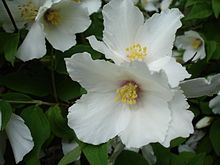| Mock-orange | |
|---|---|

| |
| Philadelphus × purpureomaculatus, cultivar 'Belle Étoile' | |
| Scientific classification | |
| Kingdom: | Plantae |
| Clade: | Tracheophytes |
| Clade: | Angiosperms |
| Clade: | Eudicots |
| Clade: | Asterids |
| Order: | Cornales |
| Family: | Hydrangeaceae |
| Subfamily: | Hydrangeoideae |
| Tribe: | Philadelpheae |
| Genus: | Philadelphus L. |
| Type species | |
| Philadelphus coronarius L.[1] | |
| Species | |
|
About 60, see text | |
Philadelphus (/ˌfɪləˈdɛlfəs/[2]) (mock-orange) is a genus of about 60 species of shrubs from 3–20 ft (1–6 m) tall, native to North America, Central America, Asia and (locally) in southeast Europe.
They are named "mock-orange" in reference to their flowers, which in wild species look somewhat similar to those of oranges and lemons (Citrus) at first glance, and smell of orange flowers and jasmine (Jasminum). But Philadelphus is a basal asterid, not closely related to Jasminum (advanced asterids), and among the eudicots quite distant from Citrus (advanced rosids). An entirely misleading name for Philadelphus that is sometimes encountered is syringa;[3] this properly refers to the lilacs, which are fairly close relatives of jasmine. The connection of the two shrubs lies in their introduction from Ottoman gardens to European ones, effected at the same time by the Holy Roman emperor's ambassador to the Sublime Porte, Ogier Ghiselin de Busbecq, who returned to Vienna in 1562. The two shrubs appear together in John Gerard's Herball, as "Blew Pipe" (the lilac) and "White Pipe Tree", for the woods of both are pithy and easily hollowed out.[4]
Philadelphus is named after an ancient Greek king of Egypt, Ptolemy II Philadelphus.[citation needed]
- ^ Philadelphus | International Plant Names Index. (n.d.). Retrieved January 6, 2024, from https://www.ipni.org/n/30007321-2
- ^ Sunset Western Garden Book, 1995:606–607
- ^ "State Symbols USA: Idaho State Flower". 2 October 2014.
- ^ Alice M. Coats, Garden Plants and Their Histories (1964) 1992, s.v. "Philadelphus".